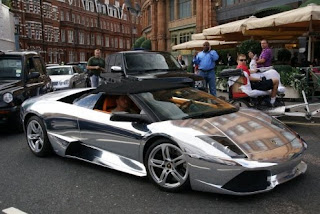
|
|---|
|
|---|
Wednesday, June 30, 2010
Jaguar XKR 75 2010
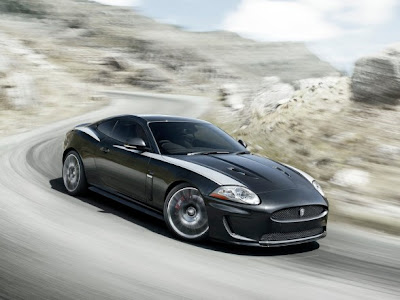
The uniqueness of exclusive features of the new XKR 75 include increased performance by recalibrating the engine and transmission details, more power to 530p (compared with 510 PS on XKR), not much at 655nm torque (625Nm at cons XKR). In Jaguar XKR 75 there is no torque converter upgraded to handle the increased torque, suspension system enhanced to improve the accuracy and agility, increase the spring and damper rates (spring 28 percent of the front springs are fixed at the rear 32 percent more rigid), new aluminum front, the engine and completely revised rear suspension for improved vertical camber stiffness (up 25 per cent), dynamic Adaptive Re-listening damper control software, reduce no. ride height (15mm front and 10mm rear). This Jaguar features Body Pack finished aerodynamic body color front splitter, rocker extensions and rear diffuser, and body colored rear spoiler and larger rear deck lid finisher.
Labels:
Jaguar
Tuesday, June 29, 2010
2010 Tesla Roadster TAG Heuer

Labels:
Tesla
Mitsubishi Eclipse 2011 Vehicle Overview
 The 2011 Mitsubishi Eclipse coupe, however, just can't keep up with the latest sport coupes and hot hatches. Pros, Avant-garde styling, one of the few convertibles in its price range, powerful V6 in GT, comfortable front seats, relatively roomy cargo area. Cons, Poor outward visibility with convertible, sluggish acceleration with GS models, torque steer with GT, small backseat, no telescoping wheel, lackluster interior quality.
The 2011 Mitsubishi Eclipse coupe, however, just can't keep up with the latest sport coupes and hot hatches. Pros, Avant-garde styling, one of the few convertibles in its price range, powerful V6 in GT, comfortable front seats, relatively roomy cargo area. Cons, Poor outward visibility with convertible, sluggish acceleration with GS models, torque steer with GT, small backseat, no telescoping wheel, lackluster interior quality.The dearth of similarly priced convertibles makes the Eclipse Spyder worth a look. The base 2011 Mitsubishi Eclipse gets a price reduction for 2011 and standard alloy wheels. Heated leather front seats and a power driver seat are now standard on the GS Sport. The GT can no longer be had with a manual transmission. All Eclipse coupes get a blacked-out roof.
Powertrains and Performance
Every 2011 Mitsubishi Eclipse is front-wheel drive. GS models are powered by a 2.4-liter four-cylinder that produces 162 horsepower and 162 pound-feet of torque. The GS comes standard with a five-speed manual, while a four-speed automatic is optional on the GS and standard on the GS Sport. Estimated fuel economy with the automatic is 20 mpg city/28 mpg highway and 23 mpg combined.
The Eclipse GT gets a 3.6-liter V6 good for 265 hp and 262 lb-ft of torque. A five-speed automatic is standard. This engine requires premium fuel and its estimated fuel economy is 16 mpg city/24 mpg highway and 19 mpg combined.
 Safety
SafetyThe 2011 Eclipse comes standard with four-wheel antilock brakes, stability control and front seat side airbags. The coupe features front side curtain airbags and the Spyder gets taller side airbags that cover occupants' heads. There are no rear head restraints. The Eclipse Spyder received the Insurance Institute for Highway Safety's top rating of "Good" in both the frontal-offset and side crash tests.
 Driving Impressions
Driving ImpressionsFor many drivers, the 2011 Mitsubishi Eclipse's driving dynamics may be a bit of a disappointment. The GT's V6 produces plenty of power, but getting all those horses to the pavement can often result in a large dose of wheelspin and torque steer. In contrast to the V6, the four-cylinder struggles with the Eclipse's heavy curb weight -- acceleration with the smaller engine could best be described as anemic.
Another item of contention would be the large turning circle, which necessitates many more multiple-point turns than with other vehicles. Overall handling should satisfy most drivers, but those with an appetite for performance would likely find inspiration in any number of competing sport coupes or hatchbacks. The Spyder exhibits a little more chassis flex over bumps than we'd like, but it's not enough to spoil an otherwise enjoyable driving experience.

Labels:
Mitsubishi
Honda CR-Z 2011 Review
 A sporty hybrid? At first glance, the 2011 Honda CR-Z might seem a bit oxymoronic. After all, Americans expect their hybrid cars to be purely about fuel economy, with flowers, rainbows and unicorns coming out of the tailpipe. But Honda is hoping that people are ready for a car that not only gets very good fuel economy but also happens to be fun to drive -- a hybrid without the drive-induced narcolepsy, if you will.
A sporty hybrid? At first glance, the 2011 Honda CR-Z might seem a bit oxymoronic. After all, Americans expect their hybrid cars to be purely about fuel economy, with flowers, rainbows and unicorns coming out of the tailpipe. But Honda is hoping that people are ready for a car that not only gets very good fuel economy but also happens to be fun to drive -- a hybrid without the drive-induced narcolepsy, if you will. Hard-core enthusiasts will likely be disappointed, but somebody just looking for a sporty two-door with good fuel economy will likely be pleased with the 2011 Honda CR-Z.
Hard-core enthusiasts will likely be disappointed, but somebody just looking for a sporty two-door with good fuel economy will likely be pleased with the 2011 Honda CR-Z. Pros, Nimble size and handling, quick steering, good fuel economy, sporty looks. Cons, Poor rearward visibility, most competitors have backseats, missing a few upscale features.
Pros, Nimble size and handling, quick steering, good fuel economy, sporty looks. Cons, Poor rearward visibility, most competitors have backseats, missing a few upscale features.

Honda Odyssey 2011 Vehicle Overview
 The all-new 2011 Honda Odyssey looks poised to pick up from where its class-leading predecessor left off. The Honda Odyssey is completely redesigned for 2011.
The all-new 2011 Honda Odyssey looks poised to pick up from where its class-leading predecessor left off. The Honda Odyssey is completely redesigned for 2011.The minivan isn't as popular as it once was, but it remains the quintessential form of transportation for families big and small. No other vehicle offers the type of versatility and space for kids and the copious amount of stuff that invariably comes along with them. The 2011 Honda Odyssey is a completely redesigned entry among this dwindling number of minivans, replacing a model that was widely considered to be the best in its class for a decade. In other words, it has some very big shoes to fill.
 The 2011 Odyssey is an inch-plus shorter in height than before, but has gained an inch-plus in width, creating a slightly sleeker appearance aided by a wedge-shaped front fascia and unique "lightning-bolt" character line. Aside from being a design flourish, this character line also improves visibility for passengers in the third row of seats, who will also enjoy a greater amount of knee and shoulder room. Honda says three adults can sit back there, but we're thinking the middle spot's fold-down armrest will be utilized more frequently.
The 2011 Odyssey is an inch-plus shorter in height than before, but has gained an inch-plus in width, creating a slightly sleeker appearance aided by a wedge-shaped front fascia and unique "lightning-bolt" character line. Aside from being a design flourish, this character line also improves visibility for passengers in the third row of seats, who will also enjoy a greater amount of knee and shoulder room. Honda says three adults can sit back there, but we're thinking the middle spot's fold-down armrest will be utilized more frequently. Minivans are renowned for setting themselves apart with never-before-seen features. Some, like the Odyssey's flip-and-fold third-row seat became an industry standard, while others, like the last Odyssey's middle-row Lazy Susan storage bin have been quickly forgotten. This time around, the Odyssey introduces a small refrigerated storage compartment beneath the center stack controls, a trash bag holder, second-row seats that shift laterally to make room for child seats and a wide-screen entertainment system with an HDMI input. The new Odyssey also improves upon previously introduced features, like a simplified process for lowering the third-row seat and an enlarged second-row removable middle seat.
Minivans are renowned for setting themselves apart with never-before-seen features. Some, like the Odyssey's flip-and-fold third-row seat became an industry standard, while others, like the last Odyssey's middle-row Lazy Susan storage bin have been quickly forgotten. This time around, the Odyssey introduces a small refrigerated storage compartment beneath the center stack controls, a trash bag holder, second-row seats that shift laterally to make room for child seats and a wide-screen entertainment system with an HDMI input. The new Odyssey also improves upon previously introduced features, like a simplified process for lowering the third-row seat and an enlarged second-row removable middle seat. Honda has not yet released full details about the 2011 Odyssey's powertrain, but we do know it will continue to only be available with front-wheel drive and a 3.5-liter V6. Honda's cylinder deactivation system is now standard on every Odyssey and fuel economy is estimated to be 19 mpg city and 28 mpg highway. This is a significant improvement versus the last Odyssey (especially those trims without cylinder deactivation) and better than the new Toyota Sienna's four- and six-cylinder engines.
Honda has not yet released full details about the 2011 Odyssey's powertrain, but we do know it will continue to only be available with front-wheel drive and a 3.5-liter V6. Honda's cylinder deactivation system is now standard on every Odyssey and fuel economy is estimated to be 19 mpg city and 28 mpg highway. This is a significant improvement versus the last Odyssey (especially those trims without cylinder deactivation) and better than the new Toyota Sienna's four- and six-cylinder engines. More details about the 2011 Honda Odyssey will be coming soon, including available trims and equipment, as well as exact dimensions and specifications. Check back for a full review of how this new Odyssey stacks up against its minivan competitors before it hits dealerships in the fall.
More details about the 2011 Honda Odyssey will be coming soon, including available trims and equipment, as well as exact dimensions and specifications. Check back for a full review of how this new Odyssey stacks up against its minivan competitors before it hits dealerships in the fall.
Labels:
honda
Renault Megane Trophy (2009)
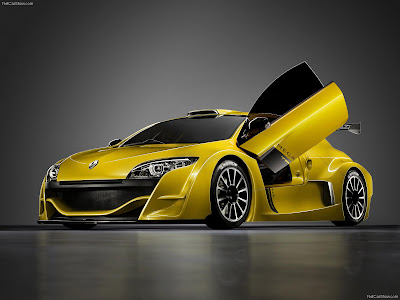
The new Renault Mégane Trophy features the same mechanicals as the current car, including an FIA-homologated sports-prototype tubular chassis, a mid-rear V6 3.5 24V engine.The most visible change concerns its new body design which takes its inspiration from the lines of New Mégane Coupe. Under the bonnet, a fresh look has also been taken at the Renault-Nissan Alliance's V6 3.5 24V powerplant which now delivers 360hp.A new inlet manifold, which is fed by roof-mounted air-ducts, has taken engine power from 330 to 360hp. The new car's reliability is as excellent as ever with rebuild intervals of every 5,500km. Combined with the aerodynamic gains, the extra power output of the V6 3.5 24V engine will enable new Renault Mégane Trophy to lap in times similar to those of a Porsche GT3.
Labels:
Renault
TechArt Porsche Carrera GT


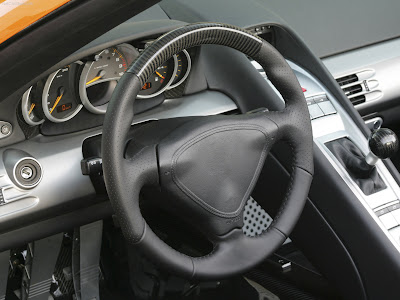
The TechArt designers have developed aerodynamically efficient custom-tailored body components made from exposed carbon fiber that serve as a visual contrast to the metallic-orange special paint.Both benefit not only the engine sound that escapes through the two production tailpipes; the modifications also increase maximum power output from 612 hp / 450 kW to some 635 hp / 467 kW.The low-reaching front spoiler reduces lift on the front axle at high speeds further and thus further optimizes directional stability.TechArt has also developed a three-piece gurney flap that serves as the aerodynamic counterpart in the rear.The center piece of the separation edge extends together with the pop-up rear wing and in combination with the fixed spoiler edges on the left and right produces additional downforce on the rear axle.
Labels:
Porsche
Bentley Continental Supersports Convertible




The new Supersports Convertible, with the same 630PS (621bhp/463kW) twin-turbocharged W12 engine, is the fastest, most potent drop-top Bentley has ever built, offering the ultimate Bentley driving experience in the world's most dramatic convertible.A highly focussed, pure Bentley driving experience
With 630PS (621bhp) and 800Nm (590lb ft) of torque from its pioneering FlexFuel engine and new 'Quickshift' transmission, the Bentley Continental Supersports Convertible is the fastest drop-top Bentley has ever built. It accelerates from 0-60mph in 3.9 seconds (0-100km/h in 4.2 seconds) and, conditions permitting, can continue onto a top speed of 202mph (325km/h).The Bentley Continental Supersports Convertible also shares its ride height with the GTC Speed, sitting 10mm (0.4in) lower at the front and 15mm (0.6in) lower at the rear than the standard GTC.The 9.5Jx20-inch forged alloy wheels, shared with the Supersports Coupé, offer a weight saving of 10kg (22lb) per car, reducing unsprung and rotating mass while the open 10-spoke design offers superior brake cooling. The rear wheels have a 25mm (1 inch) greater offset resulting in a 50mm (2 inches) increase in the rear track, further benefiting handling and stability.Eye-catching, black gloss Bentley-branded brake calipers act on the carbon ceramic brakes. Surrounding the brakes are the unique 20-inch, forged alloy wheels with Smoked Steel-finish which are exclusive to Supersports models. Large diameter tailpipe trims round out the car's purposeful stance when viewed from the rear. Beneath the bonnet Supersports badges grace the cover of the 630PS (621bhp) W12 engine.
Labels:
Bentley
ABT VW New Beetle Cabriolet
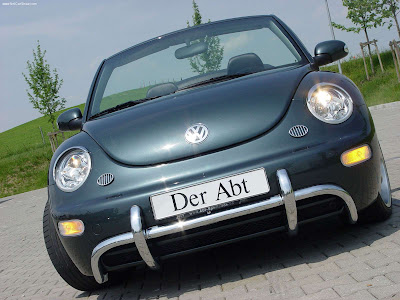
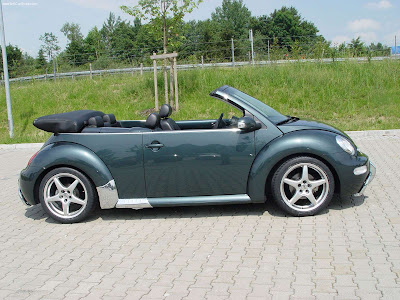
The ABT VW New Beetle Cabriolet including two types of back-silencers, an aluminium gear lever knob, aluminium pedals, stainless steel running boards, as well as a set of floormats displaying the Abt Sportsline logo. Additionally, a New Beetle owner can choose between 14 wheels, one of them being the brand-new Z5 wheel (8 x 18") presented on the IAA motor show.The 2.0-litre engine receives a power plus to ca. 105 kW (143 hp) thanks to capacity enhancement by 200 cubic centimetres, a customized Abt crankshaft, special pistons, Abt camschafts, a cylinder head modification, a mid-silencer, optimised air ducting as well as changes to the electronic engine management. Abt expertise in the ECU field ensures an increase in the 1.8-litre turbo-engine from 110 kW (150 hp) to 142 kW (193 hp). For the 1.9-litre TDI, Abt provides an increase from 66 kW (90 hp) to 85 kW (112 hp).A front grill, chrome fog headlamp frame, headlamp visor and the matching V-rims (7.5 x 17 inch) rounds off the New Beetle body kit from the House of Abt.A very special example of the New Beetle caused a sensation in German rallying: Together with natural gas supplier Thyssengas, Abt enters a Beetle in the German Rally Challenge series and the German Rally Championship. The highlight: The 230 hp model uses natural gas instead of traditional fuel.
Labels:
ABT
2010 9ff SPEED 9
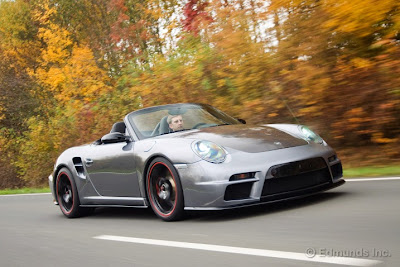
2011 Mercedes SLS AMG GT3
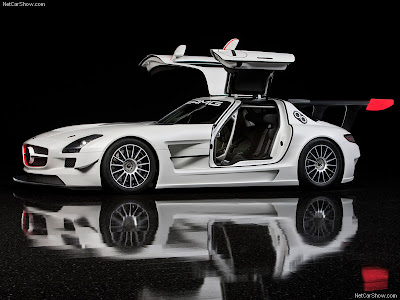
Need For Speed Carbon RX 7

Labels:
Mini,
Need for speed
High Horse Power Car
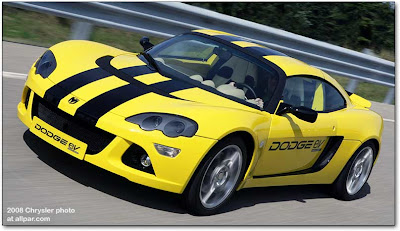

I.D.E.A KAZ
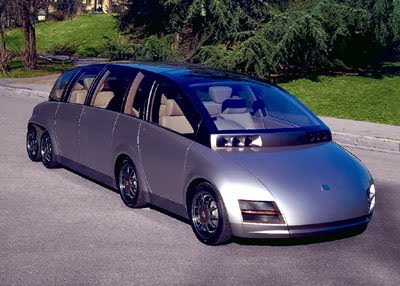
Monday, June 28, 2010
Citroen DS3 Racing (2011)
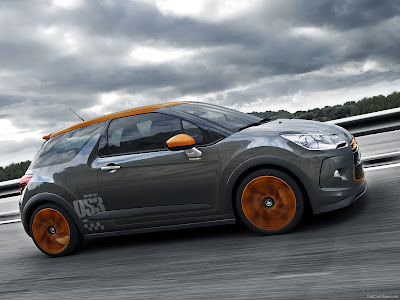

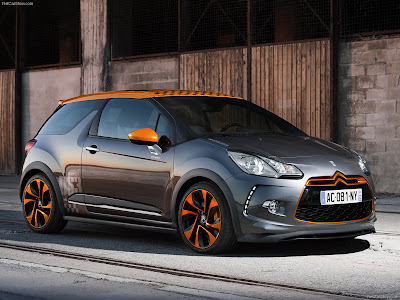

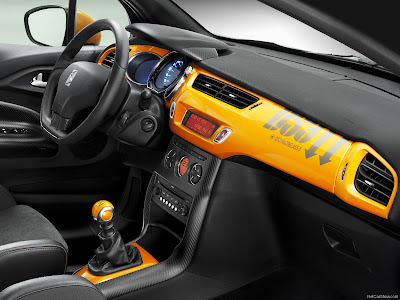
Citroën DS3 Racing is a special edition with a 100% sporting pedigree.The exclusive Citroën DS3 Racing will be limited to just 1000 production units.With integrated carbon-trimmed components and specialist motorsports equipment, Citroën DS3 Racing's tuned and turbo-charged 1.6-litre THP 150 engine develops 200hp - a power increase of almost 30% over the standard unit - with a torque increase of 15% from 240Nm to 275Nm.The Citroën DS3 front wheels get 4-piston racing callipers and special disc-brakes - with drilled discs at the rear.The new Citroën DS3 Racing edition inherits Citroën Racing's expertise in motorsport design to provide advanced technological and stylistic sporting prowess.Based on the existing DSport powered by the THP 150, production Citroën DS3 Racing editions will be finished in a special workshop and fitted with a parts kit developed according to Citroën Racing specifications.
Labels:
Citroen
Citroen REVOLTe


Citroën REVOLTe Concept also provides the option of CO2-free driving with the ability to run in all-electric ZEV (Zero Emission Vehicle) mode.At the very front of Citroën REVOLTe Concept, a backlit glass element is incorporated into the grille - this original feature highlights the chevrons above, subtly asserting the concept's identity as true Citroën.Citroën looking to the future by taking inspiration from its cool past. Where the 2CV was plain and neutral, REVOLTe is luxurious and colourful; where the 2CV was basic and simple, Citroën REVOLTe Concept is intelligent and technologically advanced and where the 2CV was slow and bouncy, REVOLTe is lively and spirited.Citroën REVOLTe is a visually-stunning low stance, Citroën REVOLTe Concept measures just 3.68m long, 1.73m wide and 1.35m tall.
Labels:
Citroen
Subscribe to:
Posts (Atom)












